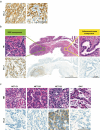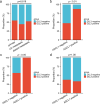Exploring the expression of DLL3 in gastroenteropancreatic neuroendocrine neoplasms and its potential diagnostic value
- PMID: 39865119
- PMCID: PMC11770191
- DOI: 10.1038/s41598-025-86237-y
Exploring the expression of DLL3 in gastroenteropancreatic neuroendocrine neoplasms and its potential diagnostic value
Abstract
Delta-like protein (DLL3) is a novel therapeutic target. DLL3 expression in gastroenteropancreatic neuroendocrine tumors (GEP-NECs) is poorly understood, complicating the distinction between well-differentiated neuroendocrine tumors G3 (NET G3) and poorly differentiated NEC. DLL3 immunohistochemistry (IHC) was performed on 248 primary GEP-NECs, correlating with clinicopathological parameters, NE markers, PD-L1, Ki67 index, and prognosis. Achaete-scute complex-like 1 (ASCL1) IHC was performed on some GEP-NECs. DLL3 IHC was conducted on 36 GEP-NETs, 29 gastric adenocarcinomas (GACs), and metastatic tumors (9 lymph node metastases and 19 distant metastases). DLL3 expression rates were 54.8% in GEP-NECs at the primary site, associated with small cell neuroendocrine carcinoma (SCNEC) (p < 0.001), chemotherapy before baseline (p = 0.015), and at least two NE markers (p = 0.048). DLL3 expression in metastatic GEP-NECs was similar to that of primary tumors. Expression rates in NET G1, NET G2, NET G3, and GACs were 0%, 0%, 15.8%, and 0%, respectively, highlighting DLL3 as a powerful tool for identifying poorly differentiated NEC. DLL3 expression was related to ASCL1 in GEP-NECs, especially in SCNEC. It was not correlated with progression-free survival (PFS) or overall survival(OS), regardless of cutoff value (1%, 50%, 75%). In conclusion, DLL3 targeted therapy may offer potential for the treatment of poorly differentiated NEC of the digestive system, although further studies are needed to validate its efficacy.
Keywords: ASCL1; Delta-like protein; Gastroenteropancreatic neuroendocrine tumors; Immunohistochemistry; Therapeutic target.
© 2025. The Author(s).
Conflict of interest statement
Declarations. Ethics declarations: Human samples and clinical data were collected and used in accordance with the principles of the Declaration of Helsinki and approved by the Ethics committee of Peking University Cancer Hospital. All participants provided written informed consent, approval number 2023KT29. Competing interests: The authors declare no competing interests.
Figures




Similar articles
-
Delta-like ligand 3 expression and functional imaging in gastroenteropancreatic neuroendocrine neoplasms.medRxiv [Preprint]. 2025 Jun 25:2025.06.24.25330227. doi: 10.1101/2025.06.24.25330227. medRxiv. 2025. PMID: 40666328 Free PMC article. Preprint.
-
Diagnostic and Predictive Role of DLL3 Expression in Gastroenteropancreatic Neuroendocrine Neoplasms.Endocr Pathol. 2021 Jun;32(2):309-317. doi: 10.1007/s12022-020-09657-8. Epub 2021 Jan 6. Endocr Pathol. 2021. PMID: 33409812
-
Expression of DLL3 and SEZ6 in the Spectrum of Neuroendocrine Neoplasia.Endocr Pathol. 2025 Jul 23;36(1):27. doi: 10.1007/s12022-025-09873-0. Endocr Pathol. 2025. PMID: 40699376 Free PMC article.
-
NETest and Gastro-Entero-Pancreatic Neuroendocrine Tumors: Still Far from Routine Clinical Application? A Systematic Review.Genes (Basel). 2025 Jan 27;16(2):161. doi: 10.3390/genes16020161. Genes (Basel). 2025. PMID: 40004490 Free PMC article.
-
Unraveling molecular pathways of poorly differentiated neuroendocrine carcinomas of the gastroenteropancreatic system: A systematic review.Cancer Treat Rev. 2017 May;56:28-35. doi: 10.1016/j.ctrv.2017.04.002. Epub 2017 Apr 17. Cancer Treat Rev. 2017. PMID: 28456055
Cited by
-
The Evolving Landscape of GEP-NENs in the Era of Precision Oncology: Molecular Insights into Tumor Heterogeneity.Cancers (Basel). 2025 Jun 21;17(13):2080. doi: 10.3390/cancers17132080. Cancers (Basel). 2025. PMID: 40647381 Free PMC article. Review.
-
Delta-like ligand 3 expression and functional imaging in gastroenteropancreatic neuroendocrine neoplasms.medRxiv [Preprint]. 2025 Jun 25:2025.06.24.25330227. doi: 10.1101/2025.06.24.25330227. medRxiv. 2025. PMID: 40666328 Free PMC article. Preprint.
References
Publication types
MeSH terms
Substances
Supplementary concepts
Grants and funding
- 2024-2-1024/Capital's Funds for Health Improvement and Research
- 7232018/Supported by Beijing Natural Science Foundation
- 92259302/National Natural Foundation of China
- Z200015/Beijing Natural Science Foundation
- 82141104/the Rare Tumor Research Special Project of the National Natural Science Foundation of China
LinkOut - more resources
Full Text Sources
Medical
Research Materials

